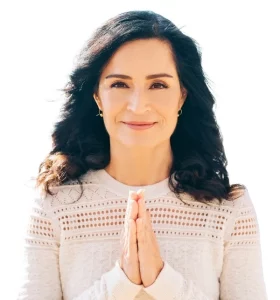The breath holds are an important part of the Joy of Breathing pranayama practice. Learning why and how to master breath holds will allow you to activate the many benefits for your health and well-being.
During the Free Weekly Online Joy of Breathing Class you are experiencing how to do a powerful pranayama exercise in a very accessible, fun and easy way. During our online sessions we are doing about 4 rounds of deep breathing and 4 breath holds. The entire breathing practice is about 15-20 minutes. You can learn more about the technique.
One round of breathing consists of about 35 to 40 breaths. Most people experience tingling, light-headed, even vibrating sensations. This is a normal part of the process. These sensations are primarily caused by the decrease in carbon dioxide (CO2) compared to oxygen (02) in the blood. This triggers a lot of physiological responses in the body.
One important response that happens is to the blood pH, causing it to become more alkaline than acidic, which is very beneficial in itself. You can learn more about the important role of blood pH and health.
After each round of breathing, you exhale and hold the breath out until you feel an urge or “hunger” for the breath, triggering the body’s natural reflexive urge to breathe in. This holding time can take approximately 1 minute, but varies from person to person based on a variety of factors.
As we are holding the breath out, C02 is slowly increasing in the body. When we hold the breath out long enough to start to feel a hunger for the breath, C02 continues to rise. The cells responds by “drinking” in the O2 for the energy.
3 Factors Effecting Your Breath Holds
Here are three important and common factors that typically effect your ability to hold your breath out. By no means are these the only reasons, but they are the most common. There can be other factors specific to you, based on your health and body.
1. How Well You Utilize O2
One factor effecting the duration of your breath hold is based on how well the body is utilizing O2. If the cells/tissues/muscles/brain are getting saturated with energy (Prana) provided by the O2, then the urge to breathe in can extend well beyond the 1 minute mark I use in the online free class.
The ability to hold the breath out longer also indicates that the blood pH is more alkaline. When the blood pH is more alkaline, then the normal breathing rate is usually slower as well. This also means a more stable blood pressure and less inflammation in the body associated with an acidic blood pH.
So an alkaline blood pH and the delivery of O2 throughout the body go hand-in-hand. But if your blood pH is normally in an acidic state, typically your breathing will be more rapid, your energy level lower, with higher inflammation in the tissues of the body.
2. Your Lung Capacity
If you are able to breath fully in and out for 35-40 breaths without strain, this is a good thing. This means your lungs are strong and doing a good job of getting O2 into the body, and CO2 out with each breath. Breathing fully from the abdomen and up into the chest expands the lungs and insures you are taking in plenty of O2. This in turn influences the amount of energy available to the cells of the body. Athletes also use this technique to tap deep into the body for greater stamina and strength, and even to influence the autonomic nervous system.
If you feel strained during the 35 to 40 breaths, you can go slower, find a rhythm and depth of breathing that allows you to continue without creating strain. With practice you will be able to do 35-40 breaths with less effort. And when you can, this is a sign that you have increased your lung capacity, strengthened your diaphragm (important breathing muscle), and that you are taking in enough 02 to tap into more energy for your body, brain, and energetic system..
3. Your Emotional And Energetic Patterns
The breathing process restores the flow of the life force energy in the body. We are also learning how to tap deep into the body, mind, energy and emotions. So if there is fear of feeling something, fear of letting go, fear of remembering trauma, fear of re-experiencing buried emotions, fear of survival even, this affects the breathing. No surprise, right!?
Fear and unresolved emotions can be triggered during the breathing and/or during the breath holds. Holding the breath out specifically can trigger buried fear. But it also can provide relief from emotions that are contributing to chronic stress and anxiety.
So, during this breathing and during the holds, be a witness to what you are experiencing in your body. Do you feel resistance to deep breathing? Do you become tight, anxious, angry, impatient? Your body may be resisting deep breathing because it starting to move energy, blocked emotions, and mental energetic patterns held in the body.
If you just continue to breath, to feel, to allow your body to feel whatever you feel inside, the body will begin to relax and let go into the process. Just keep breathing, go with the flow, and you will start your journey toward discovering physical, mental, and emotional healing and well-being.
Holding The Breath In
After you hold your breath out long enough to feel a hunger for the breath (about 1 minute in the online class), you will then take a full breath in. If you are able to hold your breath out long enough to feel a slight “hunger” for the breath, when you breathe in the increase in CO2 will now have the effect of opening the lungs even more (vasodilation).
As you hold the full breath in, norepinephrine (adrenaline) is being released into the body, having an anti-inflammatory effect on the body. Just hold the breath in for 5 or 10 seconds. No feeling of stain or need to hold it in very long.

How To Experiment With Your Breath Holds
As you are learning this breathing practice, you may not be able to hold your breath out for 1 minute. That’s okay. Here is what you can do…
Hold the breath out for as long as YOU can, until YOU feel the distinct urge to breathe in. Then breathe in and hold the breath in for about 3-5 seconds. Then exhale and hold the breath out again. Waiting again until you feel the urge to breath in.
You might have reached the 1 minute mark after the second hold. If not, do another hold of the breath out. Repeat if necessary.
Conclusion
Practicing the breath holds is an integral part of the Soul Dimension Breathing pranayama. They allow us to learn to tap into deeper levels of the body, mind and energy to influence our well-being. This includes accelerating healing, finding relief from chronic inflammation, releasing negative thought patterns and emotions that are affecting our well-being.
So friends, lets keep those conscious, deep breaths flowing, and experience an increase in health, vitality, joy and peace.




